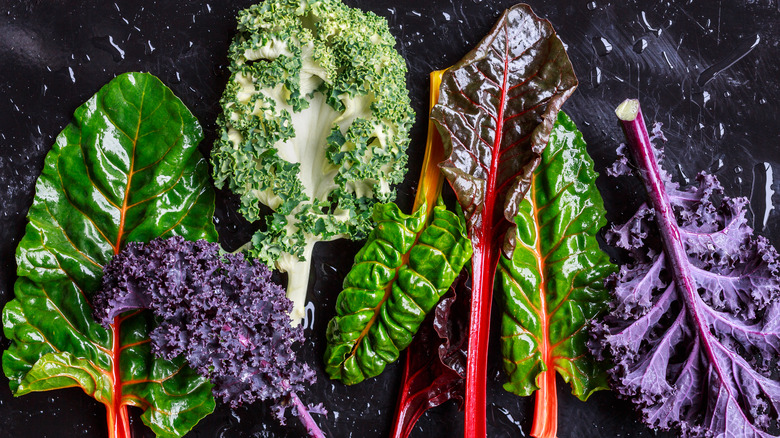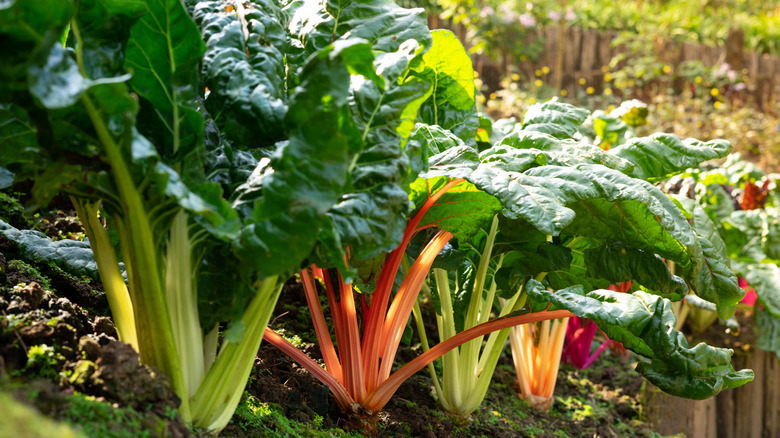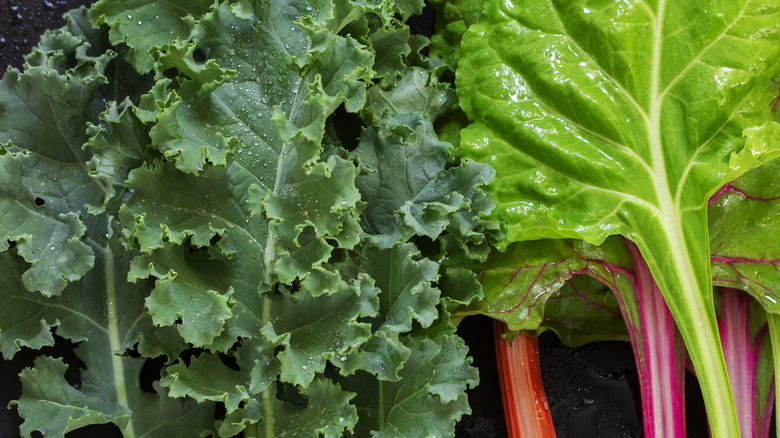What's The Difference Between Kale And Chard?
Those who eat greens often likely know that there are seemingly endless options available. Whether you dine out or stroll through the produce department of your grocery store, chances are you'll see more than a handful of varieties. From salad mixes like baby greens, spinach, arugula, and romaine to the larger leaves of kale and swiss chard, it can be a little overwhelming to branch out — especially if you're not sure which will work best in a recipe or that which one you are most likely to enjoy.
Kale and chard are two of the most common and popular options for leafy greens. They are both known for their unique health benefits, but they differ in their flavor, texture, and ease of preparation. But despite their commonalities and prevalence, you might still be wondering what the differences between kale and chard are. Once you understand what each type of leafy green brings to the table, you can more easily decide which one is right for you and your cooking needs.
What is kale?
Kale is a leafy green vegetable that belongs to the Brassica family, which also includes broccoli, cauliflower, and Brussels sprouts. It is a nutrient-dense food that is packed with vitamins and minerals, such as vitamin A, vitamin C, calcium, and iron. Kale has a tough, fibrous stem and curly leaves that are usually dark green, although there are also varieties that have red, purple, or white leaves among numerous others.
Kale has a distinctive flavor that can be described as earthy and bitter. Its texture is also unique, with a slightly crunchy and chewy texture that makes it perfect for salads and stir-fries. However, some people find kale to be too bitter and tough, which can make it difficult to enjoy. Though there are techniques and ways to prepare kale to tenderize it, it still isn't always the most appealing or pleasing option for everyone.
What is chard?
Chard, on the other hand, is a leafy green vegetable that belongs to the Amaranthaceae family, which also includes spinach and beets. It is a rich source of vitamins A, C, and K, as well as minerals like magnesium and potassium. Chard has large, glossy leaves that are usually deep, glossy green. Its stems, which can be red, yellow, or orange, are thick and fleshy and can also be eaten, but they are usually cooked separately from the leaves. This prevents the leaves themselves from becoming mushy while the stems continue to cook through.
Chard has a milder flavor than kale, with a slightly sweet and earthy taste that is less bitter. Its texture is also more tender and delicate, which makes it easier to eat raw or cooked. Chard can be enjoyed in a variety of dishes, including soups, stews, and stir-fries. Given its less intrusive flavor and more delicate leaves, chard is a leafy green that is similar, but often more enjoyable than kale.
How are they different?
The most obvious difference between kale and chard is their taste. Kale has a stronger, more bitter flavor than chard, which can make it less appealing to some people. Chard, on the other hand, has a milder, sweeter taste that is easier to enjoy. Additionally, chard has a more delicate texture than kale, which makes it easier to prepare and cook.
Deciding whether to choose kale or chard depends on your personal taste preferences and dietary needs. If you enjoy bitter, earthy flavors and prefer a crunchy texture, then kale may be the better choice for you. However, if you prefer milder, sweeter flavors and a more delicate texture, then chard may be a better option.
Another difference between kale and chard is their nutritional profile. While both vegetables are rich in vitamins and minerals, they differ in their concentrations of certain nutrients. For example, kale is a better source of vitamin K, vitamin C, and calcium, while chard is higher in vitamin A and iron.
Though kale and chard are two leafy greens that differ, they both offer a variety of health benefits and are excellent choices.



